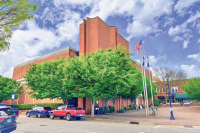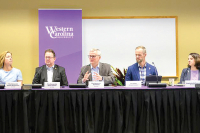The BCCCP Program: As women struggle to pay for cancer treatment, the funds to help them are drying up
By Julia Merchant • Staff Writer
A mammogram costs $200 out of pocket. A round of radiation is close to $40,000. And so far, this bill doesn’t include chemotherapy, a mastectomy, or hospital stays.
The cost of breast cancer can manifest itself in many ways, but the literal financial cost of the disease can be an almost insurmountable sum. Thankfully, many women have insurance that defrays the bill. But for those who don’t, the worry of how they’ll pay for treatment can become a nagging question — one that can prevent women from even seeking out a diagnosis, the important first step in treating breast cancer.
That’s exactly the position Haywood County resident Rhonda Gaddis found herself in three years ago. Gaddis, now 53, worked at a restaurant and didn’t have health insurance. When she found a lump in her breast, she was unsure of what to do. She felt it probably needed to be checked out, but she put off figuring out how to pay for a doctor’s visit until a co-worker told Gaddis about free physicals offered at the Haywood County Health Department.
Gaddis waited until her day off to set up an appointment. During her physical, the doctor detected the lump and recommended Gaddis take advantage of a program called the Breast Cancer and Cervical Control Program, which offers free mammograms to women ages 50 to 64.
“I had such a big knot, I think they had me at the surgeon that day,” Gaddis recalls.
Related Items
It would be a long, uphill battle for Gaddis. A mammogram and further X-rays showed she had advanced stage breast cancer that had spread to her back. She had surgery and radiation treatments on her back, as well as a mastectomy and several different kinds of chemotherapy.
And the cost to Gaddis? With the exception of some small co-pays, almost zilch.
That’s because the BCCCP, federally funded by the Centers for Disease Control, pays not only for mammograms but for biopsies, physician consultations, and more. Started in 1990, it gives county health departments funds to offer free mammograms for women ages 50 to 64 who don’t have insurance or qualify for Medicaid. It also provides mammograms to women outside that age group if they don’t qualify for private insurance. If a patient is found to have cancer, the program pays for follow-up treatments.
“This program saved my life,” Gaddis says today of the BCCCP. “I had advanced breast cancer. If it wasn’t for (the program), I wouldn’t be here right now.”
•••
Alison Best-Teague of Waynesville also credits the program for a diagnosis that likely saved her life. Best-Teague never thought she would be one to take advantage of a low-cost community health program. She and her husband are middle class with a steady income.
“I had never been in the situation to seek out community services for health care,” Best-Teague says today.
But several years ago, Best-Teague’s husband found himself between jobs, and Best-Teague lost her insurance coverage. When she sought private insurance, she was turned down — Best-Teague had melanoma when she was 28, and it prevented her from qualifying for private coverage for a subsequent 10-year period. Suddenly, Best-Teague was confronted with a few health problems that prompted her to see a doctor. He recommended she get a free mammogram through BCCCP. She had surgery after the mammogram, but nothing cancerous was found. Six months later, Best-Teague went in for a routine checkup through BCCCP. Teague didn’t think much of it until she went to talk to her doctor.
“I realized it was a different tone of voice and a different look on his face, and it did turn out to be in the early stages of cancer,” Best-Teague says of her mammogram results.
Luckily, Best-Teague’s 10-year waiting period for private insurance ended just before she received her cancer diagnosis, and she had private coverage. But without that first mammogram through BCCCP, Best-Teague doubts she would have gotten a second mammogram six months later — and possibly would have missed a cancer diagnosis altogether.
Best-Teague stresses the importance for all women to get a mammogram.
“I think because it’s a preventative thing, people may not take it seriously,” Best-Teague says. “But by the time you can feel a lump, (the cancer) is more advanced. They can see it in a mammogram way more than you can feel it (yourself),” she added.
•••
Lydia Gellis had already had the knot in her breast removed, so she was surprised when it returned. Just to be sure, Gellis went to the hospital for a routine mammogram. The test confirmed that the knot had returned in the form of breast cancer. Gellis hadn’t planned to pay for anything other than a mammogram and a biopsy, and with no insurance, wondered where to turn. Friends told her about the BCCCP, which covered the cost of Gellis’ masectomy.
“They were very good. (The Health Department) took over and directed me to where I was supposed to go and took care of it,” she says.
Now, though, Gellis wishes she had gone through with a controversial procedure not usually covered by insurance or federal programs — a preventative mastectomy.
“Now I’m constantly worried about the other breast,” she says. Though Gellis thinks she asked the doctors if they would remove the non-cancerous right breast, she isn’t sure she made her demands clear enough. She says she might recall the doctors actually telling her they couldn’t do it, but she’s not sure.
Gellis has been cancer-free more than two years after her mastectomy. She still goes for follow-ups, but has to pay out of pocket — she no longer qualifies for health services. Gellis wants to get private insurance, but says providers either tell her she hasn’t been cancer-free for long enough or ask astronomical prices that she can’t afford.
•••
The stories of Gaddis, Best-Teague and Gellis aren’t unique. Many hard-working people with full-time jobs can’t afford or can’t qualify for private insurance. The BCCCP was literally a lifesaver for these women and others who have benefited from it. Unfortunately, funds for the BCCCP are being cut in Haywood County because not enough women are taking advantage of the free mammograms that are the basis of the program.
“You have certain target numbers of women that you have to see. What we’re finding is that we are not meeting our numbers,” said Valerie Slaughter, adult health coordinator at the Haywood County Health Department.
The Haywood BCCCP will now have enough funds to see 75 women a year. By comparison, Jackson County sees nearly 150 women, according to health department director Paula Cardin, and last year Macon County saw 176, said health education supervisor Becky Barr. Swain saw 81 women — their target was 75, according to BCCCP coordinator Vicki Carroll. Three counties exceeded target goals for last year.
It wasn’t always that way for Jackson’s program, Cardin said.
“We had to really work at it. We went through a couple of years there where we just met the minimum number,” she said.
By offering free screenings to women at popular destinations such as Wal-Mart and advertising on the radio, Jackson was able to increase the number of women who came in for mammograms.
But the BCCCP program has a unique dilemma. By funding treatment for women diagnosed with cancer through the free mammogram program, the BCCCP money allotted to health departments each year gets eaten up quickly. As a result, money isn’t left over to help fund mammograms — thus making it difficult for the health department to meet its target goal of women. The program’s funding is cut if it fails to meet its target goal.
“We’re not meeting our target numbers, but we’re using up our money before the BCCCP fiscal year,” explained Slaughter.
Carroll worries that Swain might be unable to meet its target goal this year. Until recently, the health department paid for procedures only if they came back positive. The CDC has now mandated that the health department pay for all procedures related to cancer treatment.
So far this year, the Swain health department has paid for multiple procedures for two to three women. Carroll says even if the county pays for no other procedures the entire rest of the fiscal year, the program will still run out of money before the year is over.
It’s a catch-22. The more procedures a health department must pay for — and they now must pay for all required procedures — the less money the department will receive the following year when it fails to help a target number of women.
For more information:
American Cancer Society
404.320.3333 • www.cancer.org
The American Cancer Society offers a variety of services for patients and their families. The ACS has numerous contacts with various national and local organizations that support those whose lives have been touched with cancer.
Look Good....Feel Better (LGFB)
800.395.5665 • www.lookgoodfeelbetter.org
Look Good...Feel Better is a program sponsored by the American Cancer Society. Patients undergoing chemotherapy or radiation therapy may suffer effects from the medicine such as hair loss and discoloration of the skin.
Look Good...Feel Better will provide patients with cosmetics that will help them feel better.
Patient Advocate Foundation (PAF)
800.532.5274 • www.patientadvocate.org
The Patient Advocate Foundation (PAF) is a nonprofit organization that helps patients with legal counseling, referrals, insurance and financial issues. The organization also has a co-pay relief program that provide limited payment assistance for medicine to insure patients who financially and medically qualify. For more information visit www.copays.org or call 866.512.3861.
CancerCare, Inc.
800.813.4673 • www.cancercare.org
CancerCare, Inc., is a nonprofit agency that offers free support and financial assistance to those with cancer. Services are provided by oncology social workers and are available in person over the phone or through their Web site.
Y-Me National Breast Cancer Organization
800.221.2141 • www.y-me.org
The Y-Me National Brest Cancer Organization offers information and support to any one who has been touched by breast cancer. The organization services women by offering a national hotline open 24 hours-a-day, seven days-a-week, open door groups, early detection workshops, and support programs.
The program also provides wigs and prostheses free of charge to women with limited resources.









